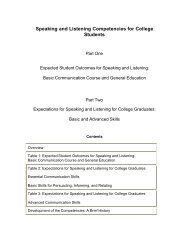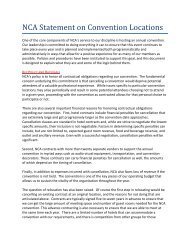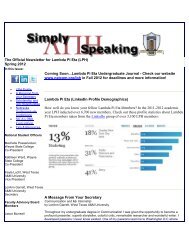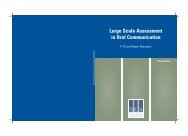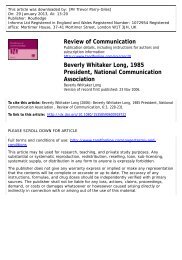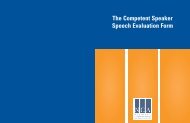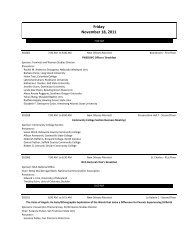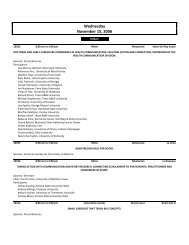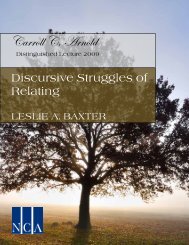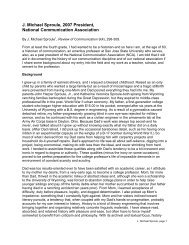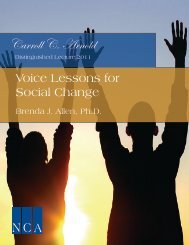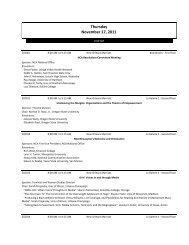Assessing Motivation to Communicate - National Communication ...
Assessing Motivation to Communicate - National Communication ...
Assessing Motivation to Communicate - National Communication ...
- No tags were found...
Create successful ePaper yourself
Turn your PDF publications into a flip-book with our unique Google optimized e-Paper software.
guage (L2) through 2 separate investigations conductedwith Japanese adolescent learners of English. In the firstinvestigation, involving 160 students, a model was createdbased on the hypothesis that WTC results in morefrequent communication in the L2 and that the attitudinalconstruct international posture leads <strong>to</strong> WTC andcommunication behavior. This model was tested withstructural equation modeling and was found <strong>to</strong> fit thedata well. The second investigation with 60 studentswho participated in a study-abroad program in theUnited States confirmed the results of the first. Finally,frequency of communication was shown <strong>to</strong> correlatewith satisfaction in interpersonal relationships duringthe sojourn.Kopfman, J., Lindsey, L., Smith, S., & Yoo, J. (2004).Encouraging family discussion on the decision <strong>to</strong> donateorgans: The role of the willingness <strong>to</strong> communicatescale. Health <strong>Communication</strong>, 16(3), 333-346.Family discussion of organ donation has been found<strong>to</strong> double rates of family consent regarding organ donation.Therefore, family discussion is an important communicationprocess <strong>to</strong> study in the effort <strong>to</strong> get morepeople <strong>to</strong> become organ donors. This investigation concernsthe willingness <strong>to</strong> communicate about organ donationand its relationship <strong>to</strong> other variables and processesrelated <strong>to</strong> family discussion of organ donation. Previousresearch on willingness <strong>to</strong> communicate examined theantecedent variables of knowledge, attitude <strong>to</strong>ward organdonation, and altruism. This research found that beingwilling <strong>to</strong> communicate about organ donation withone’s family is related <strong>to</strong> prior thought and intent <strong>to</strong> signan organ donor card, <strong>to</strong> perceiving organ donation messagesas credible, and <strong>to</strong> feeling relatively low anxietyafter reading organ donation messages. One week afterbeing presented with the messages, willingness <strong>to</strong> communicatewas found <strong>to</strong> be positively associated withworrying about the lack of donors, engaging in familydiscussion about organ donation, and having an organdonor card witnessed. It was negatively related <strong>to</strong> feelingpersonally uneasy about organ donation during thepast week.Miczo, N. (2004). Humor ability, unwillingness <strong>to</strong> communicate,loneliness, and perceived stress: Testing asecurity theory. <strong>Communication</strong> Studies, 55(2), 209-226.The purpose of this study was <strong>to</strong> develop and test atheory of the laughter-humor link in interpersonal communication.The basic premise of the theory is that asense of security underlies the ability <strong>to</strong> encode humorin everyday conversation. It was hypothesized that communication-relatedsecurity (i.e., willingness <strong>to</strong> communicate)predicts humor ability, which in turn negativelypredicts loneliness and perceived stress. Undergraduatescompleted a survey including the following scales: Unwillingness-<strong>to</strong>-<strong>Communicate</strong>,Humor Orientation, CopingHumor, revised UCLA Loneliness, and PerceivedStress. Regression analyses confirm that willingness <strong>to</strong>communicate predicted humor orientation, while humororientation mediated the relationship between willingness<strong>to</strong> communicate and coping humor. Humor orientationnegatively predicted loneliness and perceived stress,although in both cases, willingness <strong>to</strong> communicate mediatedthe relationships. The discussion highlights methodologicallimitations (e.g., use of self-report) and reiteratesthe need for interaction- and context-based studies ofthe laughter-humor relationship.Rancer, A., Trimbitas, O., & Yang, L.(2005). Ethnocentrismand intercultural-willingness-<strong>to</strong>-communicate:A cross-cultural comparison between Romanian andUS American collage students. Journal of Intercultural<strong>Communication</strong> Research, 34(1/2), 138-151.Differences on communication traits and predispositionscan influence an individual’s behavior especiallywhen engaged in intercultural interaction. Thisstudy is a cross cultural comparison of ethnocentrismand intercultural-willingness-<strong>to</strong>-communicate betweenRomanian and American college students. Onehundred and ten Romanian students and 151 Americanstudents completed a measure of ethnocentrism andintercultural-willingness-<strong>to</strong>-communicate. The resultsrevealed that Romanian students had significantlyhigher scores on ethnocentrism and had significantlylower scores on intercultural-willingness-<strong>to</strong>-communicatethan US American students. Implications ofthese findings are discussed Discussions of the differenceson these two communication predispositionsprovide information for individuals of the respectivecultures <strong>to</strong> develop more effective strategies <strong>to</strong> communicatewith each other.Personal Report of <strong>Communication</strong> Apprehension(PRCA) and Willingness <strong>to</strong> <strong>Communicate</strong>(WTC)Burroughs, N., Marie, V., & McCroskey, J. (2003). Relationshipsof self-perceived communication competenciesand communication apprehension with will-22 <strong>Assessing</strong> <strong>Motivation</strong> <strong>to</strong> <strong>Communicate</strong>




